Case Study: Farsely Springbank Primary School
By Helen Fletcher
Case Study: Farsely Springbank Primary School
By Helen Fletcher
Farsely Springbank Primary School in West Yorkshire was the School Garden winner in the National Big Wildlife Garden competition back in 2011-12. The Wildlife Gardening Forum was a partner in developing and judging the competition.
Wildlife Gardening in a School
As the part-time gardener at the school it was my decision, with the backing of the Head Teacher and funding from the school, to change the garden from a formal area with just grass and a few prickly roses to an area which would be wildlife friendly and also a great place for children to explore and have sensory experiences. Since making changes over the last 8 years, the school has experienced a wealth of wildlife from pond life, including frogs and newts to birds, hedgehogs, squirrels, foxes and an abundance of insect life.
One of our frogs posing for a photo Nest of hedgehogs discovered under a pile of old leaves .
The school is lucky to employ a designated member of staff to look after the school grounds. Having a paid employee means there is no reliance on volunteers and things don’t lapse after the novelty has worn off. I have seen many great schemes fail because the school has not continued to keep things going. We have a budget through school but have also made use of some free resources, eg. RHS School Gardening Scheme, the Woodland Trust, the Yorkshire Agricultural Society, the RSPB. There is a lot of advice and courses available for schools nationally but also locally. A local company, Outdoor Classrooms, generously donated bark, log planters and den building equipment and gave us invaluable free advice.
There are problems trying to promote wildlife gardening within a school and sometimes compromises have to be made. The Head Teacher is keen for the children to discover wildlife and care about their environment but the main push is for healthy eating so priority is often given to growing fruit and vegetables. There is a new trend for forest schooling which is great as long as the teachers and children know that the pile of logs is there for invertebrates and not den-building!
There needs to be understanding and communication amongst all staff. The school caretaker has an agenda to keep the school looking neat and tidy and so frowns upon long grass and unpruned seedheads! The Council workforce has a mission to cut everything back “tidily” and spray everything in sight! Children seldom worry about what they tread on! I suggest that anyone setting up a wildlife area bears all this in mind and zones spaces to keep a happy balance. I did once try to make the whole school grounds a wildlife haven but have realised it is a battle and I have had to compromise on some things. I now find it is easier to have designated wildlife areas so that it is obvious to everyone that it should stay “messy”!
There have been a few obstacles in my path whilst trying to establish a wildlife garden.
The school expanded a few years ago, taking it from a Junior School to a two form entry Primary School. The necessary building works destroyed some beneficial habitats including stone walls, a good area of mature flowering ivy, a large shrub area, some of the field and our lovely Nectar Bar. Luckily I was able to move some of the smaller trees. However, every cloud has a silver lining and part of the build had to include planting new trees and adding to the native hedging which I had been trying slowly to take around the whole perimeter of the school grounds to create a wildlife corridor. An added bonus was a small garden area adjacent to the new Early Years classroom which meant that the younger children could have their own outdoor space. This has been developed to include a fruit and vegetable growing area, a bird-feeding area, a wildlife area, a small wildflower area and as many nectar-rich plants as I could fit in.
I changed the wildflower spiral area into a small orchard as the spiral became too difficult to manage. I have planted a tiny wildflower patch instead on poorer soil that the builders left behind! Instead of a designated “nectar bar” we try and use nectar rich plants everywhere instead and have a long succession of flowers throughout the year from early crocus, Hammamelis and Sarcococca in the Winter to Asters and Verbena in late Autumn and a huge amount in between.



One problem I face is from neighbours to the school who constantly complain about the beautiful mature trees around the boundary – dropping leaves, casting shade, etc. Not everyone appreciates trees and wildlife and we were unfortunate to have a beautiful mature tree poisoned which then had to be felled.
We recently had to have the pond completely drained and cleared as there was a huge build-up of silt which made pond-dipping a bit of a murky experience. The pond liner was still sound but it had been originally sited beneath two huge pine trees which shed needles constantly and also a cherry tree which although very picturesque shades the pond and also means the pond needs to be netted in Autumn. If I had been able, I would have sited the pond in a more open aspect not beneath trees. Anyone putting a new pond in should bear this in mind and that ponds are high maintenance and need regular managing.
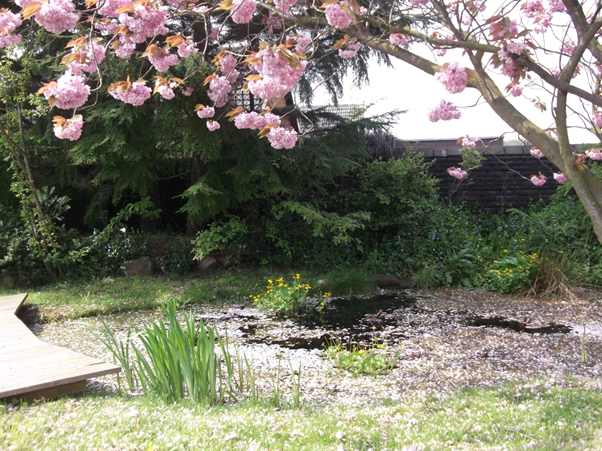
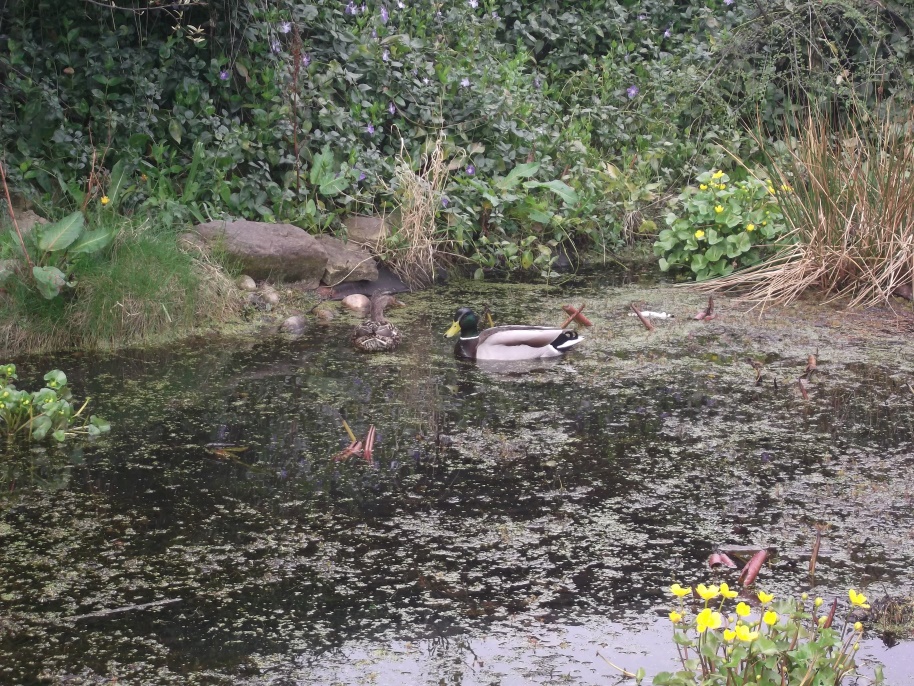
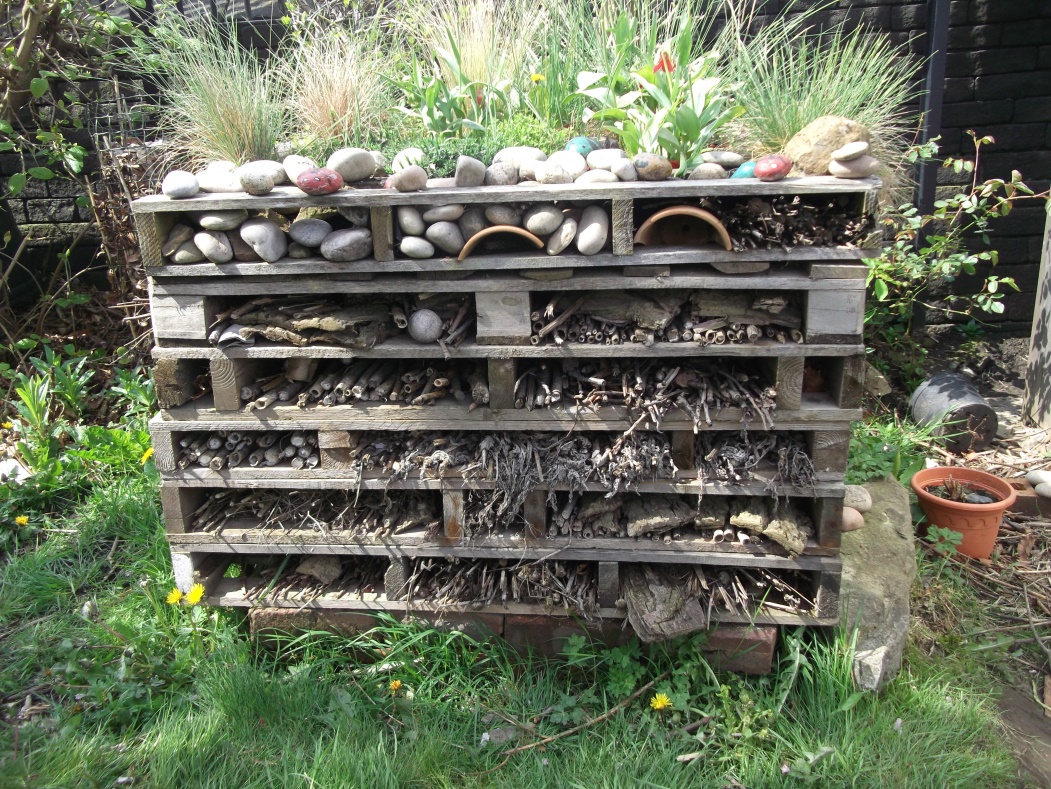
I have found that one problem with wildlife gardening is trying to grow crops alongside as organically as possible. Although the frogs do keep the slug population down considerably, wildlife areas are also great for encouraging slugs and snails!
It is disheartening for the children to see the lovely row of carrots they have sown grazed off! I have had to try growing more crops in raised beds and containers to keep them “safe”.
I also try to teach the children about companion planting to deter pests in a natural way.
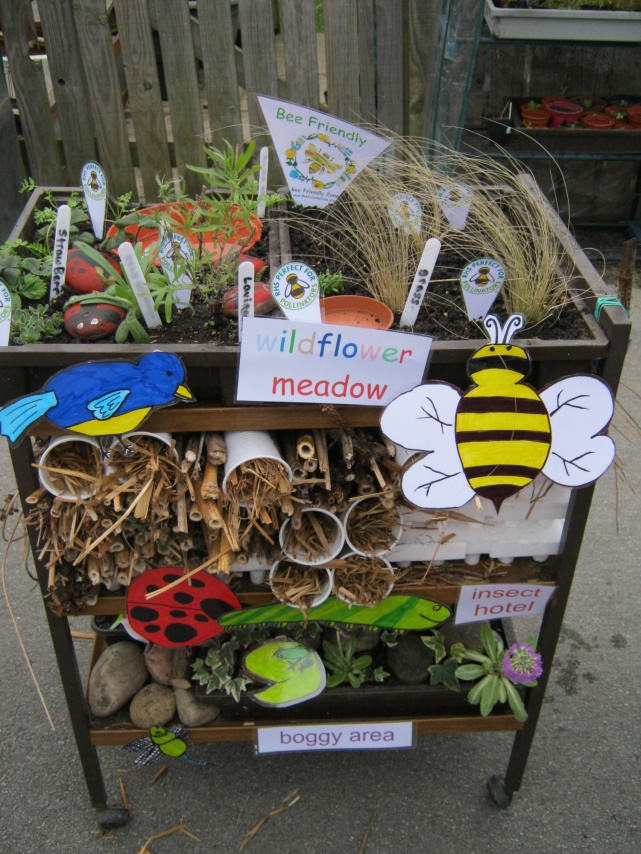
I would encourage other schools to start small and build on what they have, rather than create a huge area that becomes unmanageable.
At our school we experimented with upcycling an old tea trolley to make a moveable wildlife habitat which had a tiny amount of every habitat the children could think of. It was great fun and we could move it around the garden – the children nicknamed it “Happy Meals on Wheels”. Although it had its limitations it gave a very clear idea of the different habitats needed for different wildlife.
I have found that wildlife will always go where they want to go - I find frogs in the greenhouse all the time!
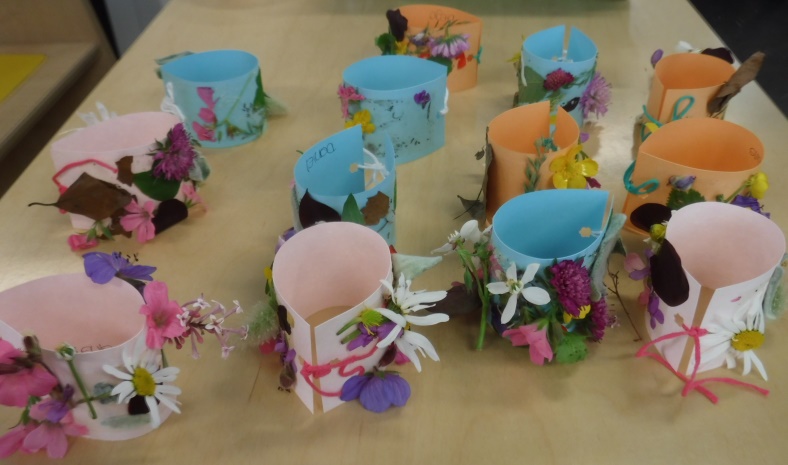
Getting children outside and letting them discover things for themselves is the key to getting them interested. Children’s response to wildlife in general is magical and they are enthusiastic. There are so many activities that children can participate in that bring them close to wildlife including bird-watching and feeding, pond-dipping, and bug hotel building.
Let children wander around with a sticky board (or bracelet for younger children) - a great way to get them to study wildflowers and grasses close up. Place a piece of wood on damp ground the night before and see what has gathered underneath the next day. Make moth traps with egg boxes and see what is there. The list is endless!
Getting children outside and letting them discover things for themselves is the key to getting them interested. Children’s response to wildlife in general is magical and they are enthusiastic. There are so many activities that children can participate in that bring them close to wildlife including bird-watching and feeding, pond-dipping, and bug hotel building.
Let children wander around with a sticky board (or bracelet for younger children) - a great way to get them to study wildflowers and grasses close up. Place a piece of wood on damp ground the night before and see what has gathered underneath the next day. Make moth traps with egg boxes and see what is there. The list is endless!


I would encourage other schools to start small and build on what they have, rather than create a huge area that becomes unmanageable.
At our school we experimented with upcycling an old tea trolley to make a moveable wildlife habitat which had a tiny amount of every habitat the children could think of. It was great fun and we could move it around the garden – the children nicknamed it “Happy Meals on Wheels”. Although it had its limitations it gave a very clear idea of the different habitats needed for different wildlife.
I have found that wildlife will always go where they want to go - I find frogs in the greenhouse all the time!
I have found that one problem with wildlife gardening is trying to grow crops alongside as organically as possible. Although the frogs do keep the slug population down considerably, wildlife areas are also great for encouraging slugs and snails!
It is disheartening for the children to see the lovely row of carrots they have sown grazed off! I have had to try growing more crops in raised beds and containers to keep them “safe”.




One of our frogs posing for a photo Nest of hedgehogs discovered under a
pile of old leaves .
The school is lucky to employ a designated member of staff to look after the school grounds. Having a paid employee means there is no reliance on volunteers and things don’t lapse after the novelty has worn off. I have seen many great schemes fail because the school has not continued to keep things going. We have a budget through school but have also made use of some free resources, eg. RHS School Gardening Scheme, the Woodland Trust, the Yorkshire Agricultural Society, the RSPB. There is a lot of advice and courses available for schools nationally but also locally. A local company, Outdoor Classrooms, generously donated bark, log planters and den building equipment and gave us invaluable free advice.
There are problems trying to promote wildlife gardening within a school and sometimes compromises have to be made. The Head Teacher is keen for the children to discover wildlife and care about their environment but the main push is for healthy eating so priority is often given to growing fruit and vegetables. There is a new trend for forest schooling which is great as long as the teachers and children know that the pile of logs is there for invertebrates and not den-building!
There needs to be understanding and communication amongst all staff. The school caretaker has an agenda to keep the school looking neat and tidy and so frowns upon long grass and unpruned seedheads! The Council workforce has a mission to cut everything back “tidily” and spray everything in sight! Children seldom worry about what they tread on! I suggest that anyone setting up a wildlife area bears all this in mind and zones spaces to keep a happy balance. I did once try to make the whole school grounds a wildlife haven but have realised it is a battle and I have had to compromise on some things. I now find it is easier to have designated wildlife areas so that it is obvious to everyone that it should stay “messy”!
There have been a few obstacles in my path whilst trying to establish a wildlife garden.
The school expanded a few years ago, taking it from a Junior School to a two form entry Primary School. The necessary building works destroyed some beneficial habitats including stone walls, a good area of mature flowering ivy, a large shrub area, some of the field and our lovely Nectar Bar. Luckily I was able to move some of the smaller trees. However, every cloud has a silver lining and part of the build had to include planting new trees and adding to the native hedging which I had been trying slowly to take around the whole perimeter of the school grounds to create a wildlife corridor. An added bonus was a small garden area adjacent to the new Early Years classroom which meant that the younger children could have their own outdoor space. This has been developed to include a fruit and vegetable growing area, a bird-feeding area, a wildlife area, a small wildflower area and as many nectar-rich plants as I could fit in.
I changed the wildflower spiral area into a small orchard as the spiral became too difficult to manage. I have planted a tiny wildflower patch instead on poorer soil that the builders left behind! Instead of a designated “nectar bar” we try and use nectar rich plants everywhere instead and have a long succession of flowers throughout the year from early crocus, Hammamelis and Sarcococca in the Winter to Asters and Verbena in late Autumn and a huge amount in between.


Farsely Springbank Primary School in West Yorkshire was the School Garden winner in the National Big Wildlife Garden competition back in 2011-12. The Wildlife Gardening Forum was a partner in developing and judging the competition.
Wildlife Gardening in a School
As the part-time gardener at the school it was my decision, with the backing of the Head Teacher and funding from the school, to change the garden from a formal area with just grass and a few prickly roses to an area which would be wildlife friendly and also a great place for children to explore and have sensory experiences. Since making changes over the last 8 years, the school has experienced a wealth of wildlife from pond life, including frogs and newts to birds, hedgehogs, squirrels, foxes and an abundance of insect life.
One problem I face is from neighbours to the school who constantly complain about the beautiful mature trees around the boundary – dropping leaves, casting shade, etc. Not everyone appreciates trees and wildlife and we were unfortunate to have a beautiful mature tree poisoned which then had to be felled.
We recently had to have the pond completely drained and cleared as there was a huge build-up of silt which made pond-dipping a bit of a murky experience. The pond liner was still sound but it had been originally sited beneath two huge pine trees which shed needles constantly and also a cherry tree which although very picturesque shades the pond and also means the pond needs to be netted in Autumn. If I had been able, I would have sited the pond in a more open aspect not beneath trees. Anyone putting a new pond in should bear this in mind and that ponds are high maintenance and need regular managing.












